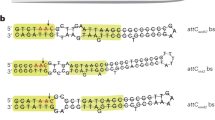Abstract
ONE of the most intriguing problems in genetics is how the regulation of a particular structural gene can be programmed in such a way that its expression can be elicited in a variety of different contexts. Stated differently, how can the concomitant expression of two or more non-contiguous structural genes capable of independent expression be achieved? Britten and Davidson1–3 have proposed a model for gene regulation which gives considerable insight into this problem. One feature of their model is the existence of positively acting regulatory genes, designated integrator genes, whose role is to achieve precisely this concomitant expression of non-contiguous structural genes. Although the model was developed to account for cell differentiation in higher eukaryotes, a similar, although possibly less elaborate, form of regulatory machinery might be applicable in lower eukaryotes. In the fungus Aspergillus nidulans, as in higher eukaryotes, functionally related genes are seldom clustered4. Given the considerable metabolic versatility of this organism, instances of inducible enzymes participating in more than one metabolic pathway should not be unduly rare. Evidence for the existence of integrator genes could come from the study of regulatory mutations affecting such enzymes. The model also requires the existence of receptor sites for integrator gene products, a not implausible requirement for A. nidulans, where several cis-acting regulatory mutations tightly linked to structural genes under their control have been identified (refs 5–8 and unpublished results of C. R. Bailey and H. N. A.). Here I report that the intAgene of A.nidulans, previously designated amdR and shown by Hynes and coworkers9–11 to be a positive regulatory gene in linkage group II involved in acetamidase synthesis, is an integrator gene of the type described by Britten and Davidson. Moreover, intA is possibly especially interesting because one of the compounds whose metabolism it controls is γ-amino-n-butyric acid (GABA), whose metabolism has been extensively investigated in a wide variety of organisms because of its role in the regulation of neuronal activity.
This is a preview of subscription content, access via your institution
Access options
Subscribe to this journal
Receive 51 print issues and online access
$199.00 per year
only $3.90 per issue
Buy this article
- Purchase on Springer Link
- Instant access to full article PDF
Prices may be subject to local taxes which are calculated during checkout
Similar content being viewed by others
References
Britten, R. J., and Davidson, E. H., Science, 165, 349–357 (1969).
Britten, R. J., and Davidson, E. H., Q. Rev. Biol., 46, 111–138 (1971).
Davidson, E. H., and Britten, R. J., Q. Rev. Biol., 48, 565–613 (1973).
Clutterbuck, A. J., in Handbook of Genetics, 1, (edit. by King, R. C.), 447–510 (Plenum, New York, 1974).
Hynes, M. J., Nature, 253, 210–212 (1975).
Arst, H. N., Jr, and MacDonald, D. W., Nature, 254, 26–31 (1975).
Arst, H. N., Jr, and Scazzocchio, C., Nature, 254, 31–34 (1975).
Lukaszkiewicz, Z., and Paszewski, A., Nature, 259, 337–338 (1976).
Hynes, M. J., and Pateman, J. A. J., Molec. gen. Genet., 108, 97–106; 107–116 (1970).
Dunsmuir, P., and Hynes, M. J., Molec. gen. Genet., 123, 333–346 (1973).
Hynes, M. J., and Pateman, J. A., J. gen. Microbiol., 63, 317–324 (1970).
Arst, H. N., Jr, and Cove, D. J., Molec. gen. Genet., 126, 111–141 (1973).
Cybis, J., Piotrowska, M., and Weglenski, P., Acta microbiol. Pol., A 4, 163–169 (1972).
Schmit, J. C., and Brody, S., J. Bact., 124, 232–242 (1975).
Cove, D. J., Biochim. biophys. Acta, 113, 51–56 (1966).
Arst, H. N., Jr, and Cove, D. J., J. Bact., 98, 1284–1293 (1969).
Alderson, T., and Hartley, M. J., Mutat. Res., 8, 255–264 (1969).
Herman, C., and Clutterbuck, A. J., Aspergillus News Lett., 7, 13–14 (1966).
Mackintosh, M. E., and Pritchard, R. H., Genet. Res., 4, 320–322 (1963).
Arst, H. N., Jr, and Page, M. M., Molec. gen. Genet., 121, 239–245 (1973).
Dover, S., and Halpern, Y. S., J. Bact., 109, 835–843 (1972).
Arst, H. N., Jr, and MacDonald, D. W., Molec. gen. Genet., 122, 261–265 (1973).
Arst, H. N., Jr, Parbtani, A. A. M., and Cove, D. J., Molec. gen. Genet., 138, 165–171 (1975).
Kinghorn, J. R., and Pateman, J. A., J. gen. Microbiol., 78, 39–46 (1973).
Kinghorn, J. R., and Pateman, J. A., J. Bact., 125, 42–47 (1976).
Skinner, V. M., and Armitt, S., FEBS Lett., 20, 16–18 (1972).
Bailey, C., and Arst, H. N., Jr, Eur. J. Biochem., 51, 573–577 (1975).
Author information
Authors and Affiliations
Rights and permissions
About this article
Cite this article
ARST, H. Integrator gene in Aspergillus nidulans. Nature 262, 231–234 (1976). https://doi.org/10.1038/262231a0
Received:
Accepted:
Published:
Issue Date:
DOI: https://doi.org/10.1038/262231a0
This article is cited by
-
A highly conserved mechanism for the detoxification and assimilation of the toxic phytoproduct L-azetidine-2-carboxylic acid in Aspergillus nidulans
Scientific Reports (2021)
-
Screening of Fungi for Potential Application of Self-Healing Concrete
Scientific Reports (2019)
-
Characterization of theugatA gene ofUstilago maydis, isolated by homology to thegatA gene ofAspergillus nidulans
Current Genetics (1996)
-
Fungal catabolic gene regulation: Molecular genetic analysis of theamdS gene ofAspergillus nidulans
Genetica (1993)
-
Analysis of the site of action of the amdR product for regulation of the amdS gene of Aspergillus nidulans
Molecular and General Genetics MGG (1992)
Comments
By submitting a comment you agree to abide by our Terms and Community Guidelines. If you find something abusive or that does not comply with our terms or guidelines please flag it as inappropriate.



